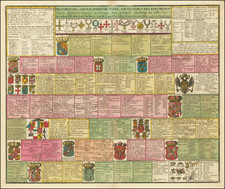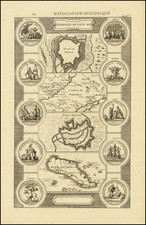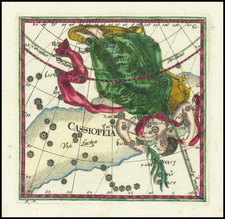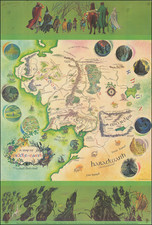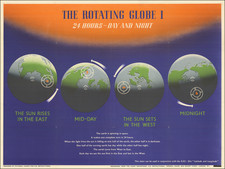Renaissance Survey of Models of the Universe and the Discussion of the Multiverse
Unrecorded variant of Johannes Praetorius' Rare Model of the Universe, which was previously only known in a single example.
Beginning with a T-O model of the world, the map presents approximately 50 concentric circles, representing a number of phenomena, including the orbits of planets, different types of stars, and a host of cosmological dimensions. The image and text would appear to be an introspective and self-aware study of the heavens, acknowledging the complexities and limitations inherent in human attempts to understand the cosmos, while also critiquing the established astronomical doctrines of the time. The author expresses reluctance to name the system "Ptolemaic-Phantastic" due to potential criticism and misinterpretation. The author's use of the word "phantastic" could imply that the Ptolemaic system is more a product of imagination than reality, reflecting the shifting views of the cosmos during a time when new astronomical models were challenging classical ideas.
The author advises the reader to turn to Virgil's 'Aeneid' as a metaphor for the study of the heavens—suggesting that just as Aeneas surveys the Trojan ranks and the procession of heroes to recognize their faces, the reader should observe and learn the "faces" of the stars or planets in the celestial "procession." The text also invokes the Biblical passage from Job 38:37, which questions mortal understanding of the divine order of the cosmos, paralleling it with Martin Luther's interpretation that emphasizes human limitations in mastering the celestial realm. The author seems to acknowledge the provisional nature of their work, suggesting that while it attempts to delineate the "reign of the heavens," it is ultimately built on the contributions of prior authorities rather than the author's innovation.
This image seems to have also been engraved by Caspar Junghans. While the sole surviving example in the Duke Anton Ulrich Museum in Braunschweig is catalogued as being printed in 1650, this dating seems unlikely, given that Johannes Praetorius (Hans Schultz) would only have been about 20 years old.
The present work likely relates to a chapter from Praetorius's annual chronicles (Zodiacus Mercurialis, 1666, 1667, 1668)
Originally engraved by Caspar Junghans, the present example is an unrecorded variant, apparently re-issued in Nuremberg by Johann Hoffman, which eliminates 3 of the celestial models on the original and replaces it with a lengthy note headed "Mercurius".
The following is an attempt to transcribe and translate the outer ring:
Vacuum supramundanum gassedq statuit hic quod a pythagore statuisse dicuntur apud pacium vidat Schwenterus in delicijs Matthem: Heruschig Comenti in prodcu dicit: P. 49 Extra Coelu Empyreum quantum humana Mens Iudicare potest nullu proleq Corpus est sed Spatiu quodda in-funitu est in quo edita Deus, ultimus et altissimq ad eog infinitq et undig circu-filfus sua essentia ex istitutibq plurimos alias mundos sivellet fabriease posset. Coeterrum Jornandus Bruno Statuit mundos infinitos in Spatio in finito Confer libellum, Appendicem hujus Tabella
Translation: The supramundane vacuum, which is said to have been established here as posited by Pythagoras at Pacium, is observed by Schwenter in 'Deliciæ Mathematicæ'. Heruschig, commenting in his work, says on page 49: 'Beyond the Empyrean Heaven, as far as the human mind can judge, there is no bodily substance, but rather a certain infinite space in which exists God, the ultimate and highest, infinite and everywhere surrounded by His essence, from which He could have created many other worlds if He had wished to fabricate them.' Furthermore, Giordano Bruno posits infinite worlds within infinite space. Refer to the booklet, Appendix of this Table.
Key points from this translation:
- Supramundane Vacuum: The concept refers to a space beyond the physical, terrestrial world, considered empty of matter but not of divine presence.
- Pythagoras at Pacium: Indicates a philosophical position attributed to Pythagoras, suggesting an early contemplation of spaces beyond the earth.
- Schwenter in 'Deliciæ Mathematicæ': Refers to discussions or observations by Schwenter, likely on topics of mathematics and cosmology.
- Heruschig's Commentary: Points to a specific statement on the nature of space beyond the highest heaven, emphasizing the absence of physical matter but the presence of God's essence.
- Giordano Bruno: Correcting "Jornandus Bruno" to Giordano Bruno, a known advocate for the infinity of the universe and the multiplicity of worlds, aligning with the text's mention of "infinite worlds in infinite space."
This passage reflects Renaissance and early modern European thought, where scholars like Giordano Bruno challenged the finite cosmological models with their ideas of an infinite universe and the potential for numerous worlds. These discussions blend the scientific with the theological, exploring the nature of the universe and the divine's role within it.
The Latin text (bottom center) below loosely translates as follows:
Mercury
Accept these well-meaning affections with a serene brow, O candid reader, our systematic labor of the Sky, which I have diligently prepared for you. But do not rashly pronounce judgment on my Uranic endeavor or established astronomical institution, as it stands. Job 38:37 asks, 'Do you know the ordinances of the heavens? Can you establish their rule on the Earth?' Or more significantly, as Martin Luther's vernacular version puts it, 'Do you know how the heavens rule, or how you can master them on Earth?' Indeed, the reign of the heavens herein has force, but it is an imaginary passion: the truth comes not from me, but from its own authors, and those scoffers who, like the Giants and Cyclopes of old, have in vain piled mountain upon mountain, and have preserved such a circular or circulatory reasoning (like that steward in Plautus' comedy, the 'Patinarius') as if standing in a lofty temple (not by virtue, but) by such an encyclopedic faith of the highest, or of all things, that you may wish to quell any desire and passion for learning, turn to Virgil's 'Aeneid', Book 2, line 68, 'He stopped, and with his eyes surveyed the Trojan ranks all around'; and also Book 6, line 754, 'And from the mound, he views the long line of heroes' procession, to learn their faces as they approach.' And this I might rightly have named the Ptolemaic-Phantastic system, in the midst of such a tumult, but due to the hasty judgment of the mercenary critics, I did not want to disdain the same work under this title. I did not want the comparison of this chart, suspect and tarnished by the name of abhorrence, to be viewed with a critical eye because of its value, which is more than worthy of your esteem. Farewell.
Johann Hoffmann, art dealer, has produced this in Nuremberg.
Johannes Praetorius
Johannes Praetorius (1630-1680) was born Hans Schultz in 1630 in Zittau, Saxony. Praetorius was a prolific German polymath whose work spanned a diverse array of subjects including history, folklore, magic, witchcraft, and the occult sciences. His contributions to the intellectual landscape of the 17th century reflect the era's complex interplay between emerging scientific inquiry and enduring mystical traditions. Praetorius's writings, characterized by an eclectic and often encyclopedic approach, provide a window into the cultural and intellectual milieu of early modern Europe, marked by its curiosity, skepticism, and the search for knowledge across both the natural and supernatural realms.
Educated at the University of Leipzig, Praetorius distinguished himself in the academic community through his broad interests and extensive scholarship. Unlike his contemporaries who often pursued specialization, Praetorius embraced a wide-ranging intellectual curiosity that led him to explore topics as varied as demonology, astrology, and the customs and beliefs of his time. This interdisciplinary approach, while not always earning the acclaim of his more focused peers, allowed Praetorius to compile a vast body of work that would become invaluable for later historians, folklorists, and cultural scholars.
Praetorius's writings on witchcraft and magic, in particular, offer insight into the period's social and psychological landscapes, reflecting both the fears and fascinations of 17th-century society. His accounts of witch trials, sorcery, and supernatural phenomena, compiled from various sources, serve not only as historical documentation but also as commentary on the human condition and the boundaries of belief and rationality.
Moreover, Johannes Praetorius was a keen observer of folk traditions and popular beliefs, documenting local customs, legends, and lore that might have otherwise been lost to time. His work in this area highlights the rich tapestry of regional cultures within Germany and underscores the importance of oral tradition in the transmission of knowledge and social values.
Despite his contributions, Praetorius's engagement with the occult and the controversial nature of some of his subjects often placed him at the margins of the academic and scientific communities of his day. Nevertheless, his legacy endures through the depth and breadth of his writings, which continue to be studied for their insights into 17th-century thought, culture, and the enduring human fascination with the world beyond the empirical.
Johannes Praetorius remains a figure of interest for scholars across disciplines, emblematic of an era at the cusp of modernity yet deeply rooted in ancient traditions and beliefs. His work embodies the transitional nature of the 17th century, bridging the gap between medieval mysticism and the dawn of the Enlightenment, and offers a rich resource for understanding the complexities of this pivotal period in European history.
Rarity
The present example is virtually unknown, and we find no surviving examples.
We note that a Johann Hoffman edition of this map is recorded in on Page 2 of the Catalog uber die im Koniglich-Bayerischen haupt-Conservatorium der Armee befinlichen Landkarten und Plane, published in Munich in 1832.









